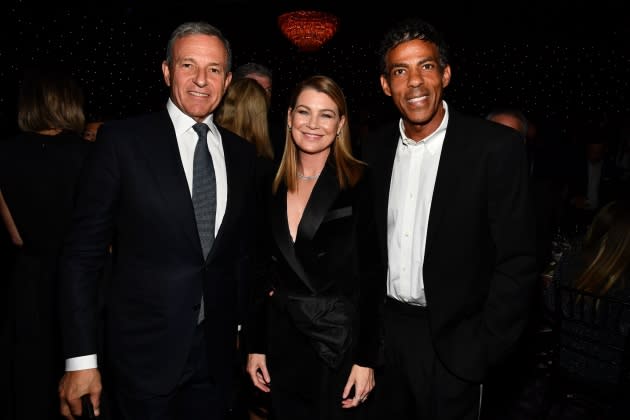Bob Iger Returns to Disney, Wall Street Mostly Cheers

If Bob Iger’s return to Disney — and Bob Chapek’s defenestration — is almost universally celebrated at Disney headquarters in Burbank, California, it is nevertheless a stark acknowledgement that the Mouse House is no longer bulletproof in the zero-sum streaming wars.
When Iger stepped down as chief executive officer in February 2020, handing the reigns to his handpicked successor, the pandemic was mere weeks away from spurring a global shutdown. (Iger remained chairman and officially retired from Disney at the end of 2021. In announcing his return, the Disney board noted that Iger’s current tenure would conclude after two years.) Managing through an unprecedented pandemic that shuttered movie theaters and theme parks worldwide, Chapek quickly reoriented the company toward streaming, burning through cash and leaving a trail of bruised egos in his wake. In hindsight, it was as an ill-fated pivot that — along with an apparent lack of interpersonal savvy so critical to Hollywood relationship management — would be his undoing.
More from WWD
Analysts complained that Chapek, in an effort to broaden the content offerings on Disney+, diluted the potency of the Disney brand. And in the most recent fiscal quarter, the company’s streaming platforms — Disney+, Hulu (a third of which is still owned by Comcast) and ESPN+ — lost a stunning $1.5 billion. A Disney+ subscription price hike, which will take effect Dec. 8, would do little to stanch the bleeding. The current commercial-free version of Disney+ will jump $3 to $10.99 each month, while a new ad-supported version will cost subscribers $7.99.
Wall Street reacted swiftly, sending Disney’s stock price plummeting 13 percent, the steepest decline since the terrorist attacks of 9/11.
“We would hope and expect that Mr. Iger examines the investment plans at Disney+ and refocuses their investment on areas of franchise strength and away from broader general entertainment content,” MoffettNathanson analyst Michael Nathanson wrote in a note to clients.
And then there are the more obvious self-inflicted wounds: an imbroglio with Florida Gov. Ron DeSantis over the state’s legislation prohibiting classroom discussion of sexual orientation and gender identity in elementary schools, the so-called “Don’t Say Gay” law; a messy legal spat with Scarlett Johansson over profits from Marvel’s “Black Widow” that smacked of misogyny, and a clumsy effort to juice theme park profits by charging customers for fast access that alienated the Disney faithful.
Iger’s first directive since the Disney board announced his sudden return has been to unwind Chapek’s unpopular executive reorganizing. In 2020, Chapek concentrated distribution responsibility for all of the company’s content under a new division, Disney Media and Entertainment Division led by Kareem Daniel. The move conferred enormous power on Daniel, a Chapek protégé, and stripped autonomy from Disney’s movie and television studio executives. Suddenly Daniel (who was first hired as an intern by Chapek) and his team were deciding which movies and TV shows would air on Disney+ or in theaters, and they had purview of content for ABC and Hulu. It was very unpopular inside Disney, multiple sources said.
(Disney declined to make executives available for interviews.)
“It is my intention to restructure things in a way that honors and respects creativity as the heart and soul of who we are,” Iger wrote in a note to employees on Nov. 21. “As you know, this is a time of enormous change and challenges in our industry, and our work will also focus on creating a more efficient and cost-effective structure.”
Daniel will leave the company, while top Disney executives including head of general entertainment Dana Walden, content studios head Alan Bergman; ESPN chief James Pitaro and chief financial officer Christine McCarthy, will help devise the new leadership structure. The move has also spurred whispers that ousted TV chief Peter Rice might return to the company. Rice, like Walden, came to Disney from Fox after Disney’s acquisition of most of 21st Century Fox assets. Rice’s detractors inside Disney contend that he never adjusted to the culture.
But Iger’s honeymoon may be short-lived, for he assumes the top job (for the second time) under very different environmental circumstances. The headwinds are severe: a looming recession that could eat into theme park attendance; declining linear TV ratings and ad revenue; the scourge of cord cutting and a stock market that is now highly skeptical of the streaming business. Disney, like its competitors including Netflix and Paramount, has seen its market valuation evaporate, losing 40 percent of its stock value since January.
“The board has concluded that as Disney embarks on an increasingly complex period of industry transformation, Bob Iger is uniquely situated to lead the company through this pivotal period,” Disney chairman Susan Arnold, wrote in a statement announcing Iger’s return to the company.
The Iger news spurred a stock bump; Disney rose 10 percent, or $12 billion in value, on Monday after the announcement. But there is some healthy skepticism that Iger’s return will fix the problems facing Disney. “We do not necessarily believe that a lack of leadership is Disney’s problem,” Cowen analyst Doug Creutz wrote in a note to clients on Nov. 21.
Iger himself, seemed to concur with that sentiment back in December 2021 when he officially retired from Disney. Speaking to CNBC’s David Faber, Iger noted: “Look, the world is changing dramatically, and it’s important for the CEO of a company to address all of those changes rapidly. Bob [Chapek] is going to address them probably differently perhaps then I may have. But that’s neither good nor bad. I think change, generally speaking…is good. Change isn’t necessarily bad.”
Iger — who ran Disney for 15 years, executing a series of industry-shaping deals including the acquisitions of Pixar, Marvel, Lucasfilm and 21st Century Fox — is clearly aware of the choppy economic waters ahead, whether he gets subsumed by them remains to be seen.

